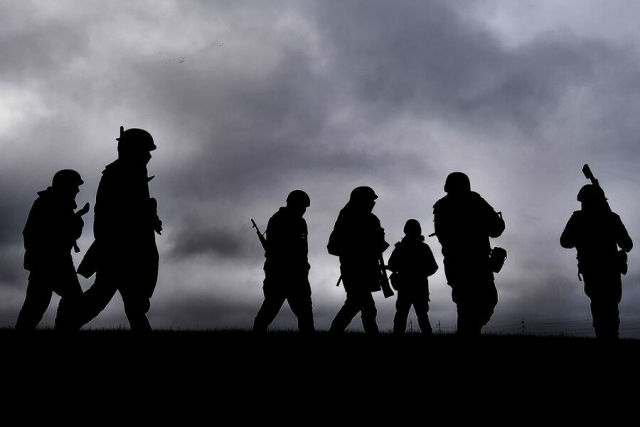Reserve Colonel Mikhail Khodarenok - about which troops in Russia should be strengthened Defense Minister Sergei Shoigu proposed to increase the number of the Russian Armed Forces to 1.5 million people and form (in some cases recreate)
a number of new associations, connections and parts. Military observer of the Newspaper.En" Mikhail Khodarenok - about which types of troops should be strengthened and what.
Along with the increase in the size of the army, the Ministry of Defense plans to create the Moscow and Leningrad military districts, form three motorized rifle divisions, an army corps in Karelia, two amphibious assault divisions, reorganize seven motorized rifle brigades into motorized rifle divisions, and form five marine infantry divisions on the basis of existing marine infantry brigades.
In addition, each combined arms (tank) army is supposed to be given a mixed aviation division and an army aviation brigade numbering 80-100 combat helicopters. In addition, three aviation divisions, eight bomber aviation regiments, one fighter aviation regiment, and six army aviation brigades should be additionally formed.
Five artillery divisions will be formed in the Rocket Forces and artillery, as well as large-capacity artillery brigades (the number of brigades is not specified).
The plans are impressive, but the main thing is not to mechanically repeat the organizational and staff structures of the Soviet and modern times, but to reach a completely new level in intelligence, management and communications. In addition, significant changes are also needed in the structure of the Armed Forces and branches of the Armed Forces. It is important not to prepare for the last war, but to plan actions taking into account the prospects for at least 40-50 years ahead.
Aviation divisions in those days were really attached to combined arms armies. For example, on the eve of June 22, 1941, the 11th Mixed Aviation Division and the 7th Aviation Brigade were part of the 3rd Combined Arms Army of the Western Special Military District, and the 9th Mixed Aviation Division (sad) was part of the 10th army of the same district. In the 9th garden, in particular, there were 429 aircraft. An absolutely incredible figure for one air division at that time, and even more so today.
However, the war showed that the distribution of aviation to operational associations of the Ground Forces is a deeply erroneous decision. In this regard, the commander of the Red Army Air Forces Pavel Zhigarev reported to Stalin on March 15, 1942, that for a successful fight against the enemy, the Red Army Air Force lacks organizational unity and unified command.
The air forces must be removed from the subordination of armies and fronts, reduced into large organizational units directly subordinate to the commander of the Red Army Air Force, who will refuel the entire aviation of the country, receiving tasks directly from the Headquarters," wrote General Zhigarev.
Therefore, it is quite possible to consider the issue of recreating operational associations in the Aerospace Forces (or at least, as an experiment, one air army) directly subordinate to the Commander-in-Chief of the Aerospace Forces. The practice of subordinating aviation to various commands does not justify itself. The air force must be united and indivisible. The same applies to army aviation. This will allow massing forces in the direction of the main strikes and solving the main tasks in the armed confrontation.
As for the formation of five artillery divisions, then, presumably, the organizational and staff structure of future formations should fully meet the requirements of the new century. This applies to the availability of modern means of conducting reconnaissance and fire correction, and the possibility of obtaining data from space reconnaissance means in real time, and the presence of a squadron of unmanned aerial vehicles in the artillery division. The main thing (no matter how banal this requirement may look) is that artillery formations should be equipped with modern weapons that surpass similar Western guns in firing range, accuracy, and fire performance. The command post of an artillery division should be equipped with an automated fire control system that allows for seconds to solve all possible (and suddenly emerging) tasks for the fire defeat of the enemy.
And modern Russian airborne and amphibious assault divisions equipped with aluminum combat vehicles and 122-mm howitzers of the 1960 model are of little use for solving any significant combat tasks.
It is certainly possible to reorganize the existing Marine brigades into five divisions. However, we should not forget that for these formations it is necessary in such a case to have the appropriate marine amphibious forces and landing facilities. Without this, the Marine Corps is no longer quite marine.
Finally, the plans of the military department to increase the number of the Armed Forces of the Russian Federation practically say nothing about the forces and means of air defense. But in the European part of the country, the combat and numerical strength of units and formations of radio engineering and anti-aircraft missile forces must be sharply, at times, strengthened.
In conclusion, it should be mentioned that there is a large amount of work to be done on the operational equipment of possible theaters of military operations. This includes the development of a transport communications system, the creation of an aviation and fleet basing system (the development of an airfield network, the equipment of shelters for aircraft, the equipment of permanent and maneuverable naval bases), the construction of control points, the construction of arsenals, bases, warehouses for storing material stocks and much, much more.
In general, it seems appropriate to clarify (perhaps further elaborate) detailed plans to increase the number of Armed Forces to one and a half million people.
The opinion of the author may not coincide with the opinion of the editorial board.Mikhail Khodarenok






